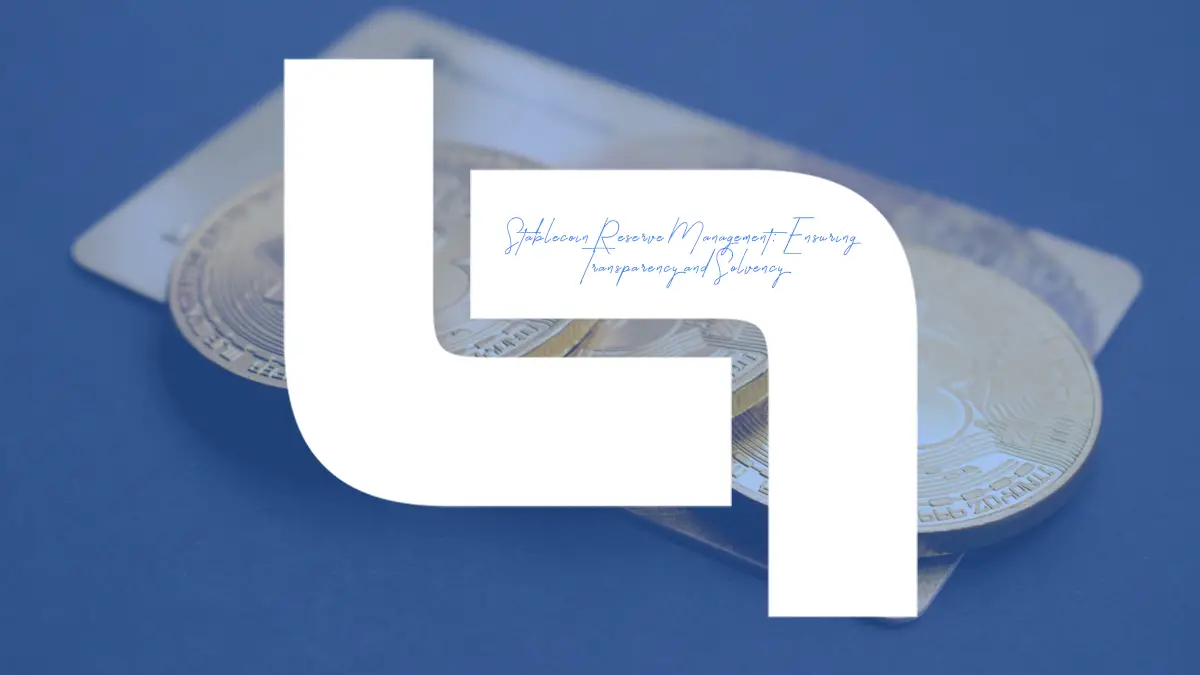Stablecoins have gained significant attention and adoption in cryptocurrencies, offering a stable and reliable digital asset pegged to a specific value, typically a fiat currency like the US dollar. One crucial aspect distinguishing stablecoins from other cryptocurrencies is their reserve management, which ensures transparency and solvency. This article will explore the importance of stablecoin reserve management and its pivotal role in maintaining trust and stability in the rapidly evolving crypto market.

What Is Stable Reserve Management?
Stablecoin reserve management refers to effectively managing and overseeing the reserves that back a stablecoin. Stablecoins are virtual currencies that aim to keep their value consistent relative to another asset, such as a fiat currency or a diversified portfolio of assets. The reserves held by the stablecoin issuer serve as collateral and provide confidence to users that the stablecoin can be redeemed for its pegged value.
Stable reserve management involves various aspects, including the selection and composition of reserve assets, risk management practices, transparency, solvency monitoring, and compliance with regulatory requirements. Ensuring that the reserves are adequately diversified, properly valued, and audited is essential to maintain transparency, stability, and solvency.
Understanding Stablecoin Reserves
Stablecoin reserves are a fundamental aspect of stablecoins, as they provide the collateral and backing for the stablecoin’s value. Understanding stablecoin reserves is crucial for assessing the stability, transparency, and solvency of a stablecoin.
The reserves of a stablecoin are used primarily for this purpose, ensuring that the stablecoin’s value remains constant. By holding assets of value that are typically less volatile than cryptocurrencies, stablecoin issuers aim to minimize price fluctuations and provide a reliable medium of exchange and store of value.
Stablecoin issuers may employ different strategies to ensure diversification and mitigate risk. For example, they may hold a combination of different asset types or maintain a specific ratio between different assets to provide stability and reduce exposure to any single asset.
Transparency in Stablecoin Reserve Management
Transparency in stablecoin reserve management is crucial for establishing trust and confidence among stablecoin users, investors, and regulators. It refers to the openness and clarity with which stablecoin issuers disclose information about their reserve holdings, valuation methods, auditing procedures, and general management practices. The following are some of the most crucial reasons why stablecoin reserve management must be transparent:
Building Trust
Transparency plays a vital role in building trust and credibility. By openly sharing information about the composition and valuation of reserves, stablecoin issuers demonstrate their commitment to maintaining the stability and solvency of the stablecoin. Users and investors are likelier to trust a stablecoin that provides transparent and verifiable information about its reserves.
Independent Verification
Transparent reserve management enables independent verification of the stablecoin’s backing. Stablecoin issuers may engage reputable auditing firms to audit their reserves regularly. These audits provide an unbiased assessment of the adequacy and authenticity of the reserves, offering assurance to stakeholders that the stablecoin is backed as claimed.
Mitigating Risks
A stablecoin’s risk may be evaluated by its stakeholders if the reserves holdings are made public. By understanding the types of assets held as reserves, their quality, and their diversification, users and investors can evaluate the level of risk exposure. Transparent reserve management helps to mitigate the risks of mismanagement, insufficient collateralization, or exposure to volatile assets.
Market Stability
Transparency in reserve management contributes to overall market stability. When stablecoin issuers provide clear and timely information about their reserves, market participants can make informed decisions regarding the stability and reliability of the stablecoin. This transparency reduces the likelihood of sudden market disruptions or loss of confidence in the stablecoin, which can have broader systemic effects.
Regulatory Compliance
Transparent reserve management is often a requirement for stablecoin issuers to comply with regulatory frameworks. Regulators may impose disclosure standards and auditing obligations to ensure stablecoin reserves are adequately managed and provide sufficient backing. Transparent practices help stablecoin issuers demonstrate compliance with these regulatory requirements, fostering a more favorable regulatory environment.
User Protection
Transparent reserve management is essential for protecting stablecoin users. By being transparent about the reserves, stablecoin issuers enable users to make informed decisions about the stability and reliability of the stablecoin. Users can assess the risks associated with the stablecoin and understand the likelihood of being able to redeem their stablecoins for the pegged value.

Ensuring Solvency in Stablecoin Reserve Management
Ensuring solvency in stablecoin reserve management is vital for maintaining the trust, stability, and reliability of stablecoins. Solvency refers to the ability of a stablecoin issuer to honor redemption requests and maintain the pegged value of the stablecoin. Here are key points to consider when ensuring solvency in stablecoin reserve management:
Adequate Reserves
The most critical aspect of ensuring solvency is having sufficient reserves to back the stablecoin’s outstanding supply. The reserves of a stablecoin must be evaluated and the reserve’s sufficiency in relation to the entire number of stablecoins must be constantly monitored. Regular evaluations and adjustments may be necessary to ensure that the reserves can cover potential redemptions.
Risk Management
Stablecoin reserves must be protected by using appropriate risk management measures. This includes diversifying the reserve assets to mitigate concentration risk and reducing exposure to volatile or high-risk assets. Stablecoin issuers should consider the quality, liquidity, and stability of the assets held in reserves to minimize potential losses and maintain solvency.
Valuation Methods
Transparent and accurate valuation of reserve assets is crucial for assessing solvency. Stablecoin issuers should establish robust and consistent valuation methods that reflect the fair value of the assets. Proper valuation practices ensure that the reserves are accurately represented and contribute to maintaining the stability of the stablecoin’s pegged value.
Regular Audits
Conducting regular audits by independent and reputable third-party firms enhances credibility and provides assurance of solvency. Audits verify the accuracy and authenticity of the reserve holdings, ensuring that they align with the disclosed information. Independent audits contribute to transparency and build trust among users and investors by verifying the solvency claims made by the stablecoin issuer.
Regulatory Compliance
Complying with regulatory requirements and guidelines related to solvency is crucial for stablecoin issuers. Regulatory frameworks may set specific reserve ratios or standards that stablecoin issuers like Qumas Ai must meet to ensure solvency. By adhering to these regulations, stablecoin issuers demonstrate their commitment to maintaining the stability and reliability of their stablecoin.
Transparent Reporting
Transparent reporting of reserve information is essential for users and investors to assess the solvency of a stablecoin. Stablecoin issuers should provide clear and timely reports on reserve holdings, valuation methods, and auditing procedures. Openly sharing this information allows stakeholders to evaluate the solvency and make informed decisions regarding the stability and reliability of the stablecoin.
Regulatory Considerations for Stablecoin Reserve Management
Regulatory considerations are crucial in stablecoin reserve management. Stablecoins are increasingly under regulatory scrutiny as digital assets with a value pegged to traditional currencies. Regulators are concerned with ensuring financial stability, investor protection and mitigating risks associated with stablecoins.
Reserve Requirements: Regulatory frameworks may impose specific reserve requirements on stablecoin issuers. These requirements define the minimum level of reserves that must be maintained relative to the outstanding supply of stablecoins. By mandating reserve ratios, regulators aim to ensure stablecoins have sufficient collateralization to honor redemption requests and maintain stability.
Conclusion
Stablecoin reserve management plays a critical role in ensuring the transparency and solvency of stablecoins. Looking to the future, continued innovation in stablecoin reserve management, such as leveraging blockchain technology for real-time transparency and exploring alternative reserve mechanisms, can further improve stability, transparency, and solvency.
Stablecoin reserve management ensures transparency and solvency in the stablecoin ecosystem. By prioritizing these factors, stablecoin issuers can build trust, protect users, and contribute to the growth and acceptance of stablecoins in the global financial landscape.

